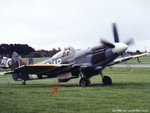A
Anonymous
Guest
pasoleati said:What are you babbling about "used" and "available" torque? Do you really understand what you write? Face this: if an engine is running at x rpm at full throttle, there is no "available" torque to accelerate anything unless the load is reduced!!! You are completely mixing part throttle and full throttle operation and inventing garbage like "available" torque.
Now, in ordinary car engines the power decreases relatively steadily as the rpm is decreased from the full power rpm down. On the other hand, torque curve starts rising with decreasing rpm (from that full power rpm) until it reaches the peak at a certain point that is highly variable with each engine. All this at FULL THROTTLE, i.e. CONSTANT MANIFOLD PRESSURE.
In supercharged aero engines the curve is of different shape as it CANNOT BE OPERATED AT CONSTANT FULL POWER MAP EXCEPT AT HIGH RPM. Get it???
Available torque is a measurment taken at less than FULL THROTTLE. Go back through this debate and you will see that the issue is available power at less than FULL THROTTLE.
So why are you babbling about FULL POWER MAP? That was not the issue we were discussing. We were discussing the ability of the engine to power up to FULL THROTTLE AND MAP when running at a lower rpm/power level, or to sustain good power levels at lower than peak rpm. And for this, AVAILABLE TORQUE is the relevant measure of that ability.
Don't you remember the point behind all this? It was that the Spitfire XIV had a higher need to maintain full RPM to sutain good power output because at less than full RPM its available torque curve drops off more sharply than that of a larger displacement engine (i.e. R-2800). Simply put, the cost in actual available power of droping RPM on the Griffon is more severe than the same % drop in RPM on the R-2800. Therefore, a smaller diameter 5 bladed prop was more beneficial to the Spitfire than it would have been to a P-47.
Get it?
=S=
Lunatic





